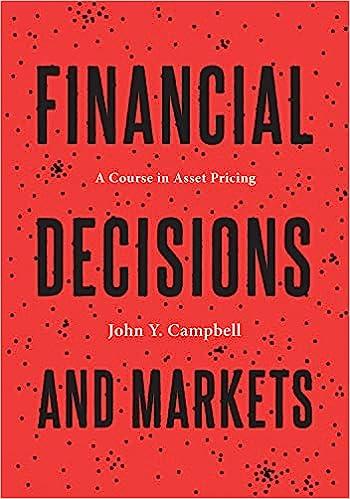In this problem we explore what information about the underlying economy we can recover from Arrow-Debreu state
Question:
In this problem we explore what information about the underlying economy we can recover from Arrow-Debreu state prices. \({ }^{10}\) Assume the existence of a representative agent with time separable utility \(U(\cdot)\) over consumption and time discount factor \(\delta\) whose Euler equations price the assets.
(a) First consider a stationary economy with no growth. Suppose there are two consumption states \(C_{H}\) and \(C_{L}\). Transitions between the two states follow a Markov process with transition probabilities given by \(f_{i j}>0\) for \(i, j \in\{H, L\}\). The four ArrowDebreu securities are denoted by \(p_{i j}>0\) for \(i, j \in\{H, L\}\). Note that \(p_{i j}\) is the price of the claim to one unit of consumption in state \(j\) tomorrow given state \(i\) today. Write down the four optimality (first-order) conditions of the representative agent. Then solve for the ratio of marginal utilities, the time discount factor, and the transition probabilities as functions of the state prices.
(b) Now suppose that there are three consumption states. Suppose also that \(p_{13}=0\), \(p_{21}=0\), and \(p_{32}=0\). What is the implication of a zero state price for the associated natural probability? Repeat the analysis of part (a). You don't need to explicitly solve the equation for \(\delta\).
(c) In parts
(a) and (b), what is the relationship between the time discount factor and the matrix of state prices?
(d) We now introduce consumption growth. Assume that given the current level, consumption grows at either the rate \(g_{H}\) or \(g_{L}\). The rate of consumption growth follows a Markov process with transition probabilities given by \(f_{i j}>0\) with \(i, j \in\{H, L\}\). Moreover, assume that the representative agent has power utility with coefficient of relative risk aversion \(\gamma\).
(i) Show that the four Arrow-Debreu prices are independent of the current level of consumption. Solve for the risk aversion parameter, the time discount factor, and the transition probabilities as functions of the state prices and the growth rates \(g_{H}\) and \(g_{L}\).
(ii) Suppose that \(p_{L H}=p_{H H}\) and \(p_{L L}=p_{H L}\). Show that recovery breaks down.
(e) Finally, continue to assume two possible growth rates \(g_{H}\) or \(g_{L}\) but allow for an arbitrary utility function. State prices will now depend on the current level of consumption in general. Show that given state prices \(p_{i j}(C)\), where \(C\) is current consumption, we can recover the natural probabilities as well as \(\delta U^{\prime}\left(g_{j} Cight) / U^{\prime}(C)\) for \(j \in\{H, L\}\). In other words, we can recover the transition probabilities, but we cannot independently recover both the ratio of marginal utilities and the time discount factor.
Step by Step Answer:

Financial Decisions And Markets A Course In Asset Pricing
ISBN: 9780691160801
1st Edition
Authors: John Y. Campbell





